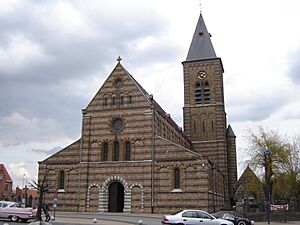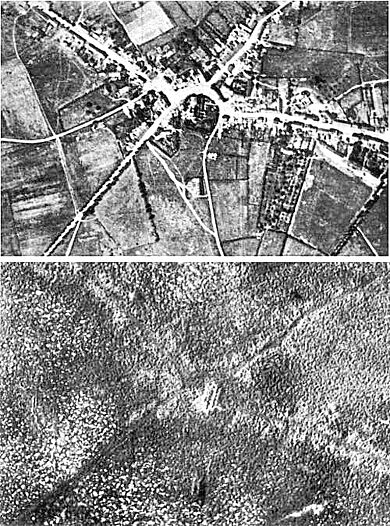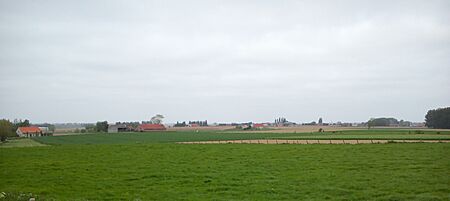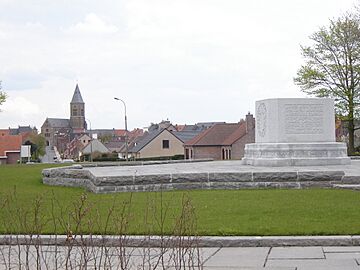Passendale facts for kids
Quick facts for kids
Passendale
Passchendaele
|
|
|---|---|
|
Deelgemeente
|
|
 |
|
| Country | |
| Province | |
| Municipality | Zonnebeke |
| Area | |
| • Total | 22.22 km2 (8.58 sq mi) |
| Population
(1999)
|
|
| • Total | 2,928 |
| • Density | 131.77/km2 (341.3/sq mi) |
| Source: NIS | |
| Postal code |
8980
|
Passendale (also called Passchendaele) is a small village in Belgium. It is located in the West Flanders province, near the town of Ypres. The village sits on a hill, separating two valleys.
Passendale is famous because it was the site of a very important battle during World War I. This battle is known as the Battle of Passchendaele.
Contents
History of Passendale
Early Beginnings of Passendale
Long ago, even before the Roman Empire was strong, the area around Passendale was a borderland. It was between two ancient tribes called the Menapii and Morini. Later, it became a border between two church regions.
The name Passendale first appeared in records in the year 844. It might have been named after a person called Paulus or Pasko. During the Middle Ages, much of this area was controlled by religious groups. These included the Augustine abbey of Zonnebeke and the Benedictine convent of Nonnebossen. Both of these buildings were destroyed in 1580 during a time when many religious images were broken.
Passendale in World War I
Passendale is best known for a major battle that happened here during World War I. This battle is officially called the Third Battle of Ypres. It took place from July 31 to November 10, 1917. British forces led the attack against German soldiers.
One big challenge was the weather. There was a lot of rain before and during the battle. This turned the battlefield into a thick, sticky mud. The ground was full of huge holes from bombs, which filled with water, dirt, and even bodies. Everything became covered in a slimy layer.
Soldiers on both sides faced terrible conditions. Guns would sink into the mud. Troops sometimes drowned in the soft ground as they tried to move forward. The water supply was also contaminated, causing many soldiers to get sick.
After sixteen weeks of fighting, the Allied forces finally reached their goal. They captured the Passchendaele Ridge. However, this victory came at a very high cost. About 270,000 Allied soldiers were killed, wounded, or went missing. German forces also suffered greatly, with around 217,000 casualties. The village of Passendale itself was completely destroyed.
Visiting Passendale Today
War Memorials and Cemeteries
Today, Passendale is a place to remember the soldiers who fought there. You can find war cemeteries from different countries. Tyne Cot Cemetery is the largest Commonwealth cemetery in the world. There are also Canadian and New Zealand memorials.
Passendale War Museum
The village also has a war museum. It tells the story of the battle and the soldiers who fought there. Many memorials are dedicated to the different countries that took part in the fighting.
Commemorative Events
Every year, Passendale holds special events and exhibitions. These remember the end of World War I. A Canadian movie called Passchendaele was made in 2008. It tells a story about the battle.
Local Products of Passendale
Passendale is also known for its delicious Passendale cheese. Every August, the village hosts a special cheese festival. There is even a blonde beer named Passchendaele. It is made by a brewery in a nearby town.
See also
 In Spanish: Passendale para niños
In Spanish: Passendale para niños





